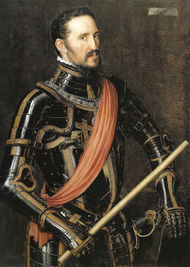Horen Restoration

The Restoration of the Imperial State, known most commonly as the Horen Restoration, began in 1526 when the Imperial State was reformed by John I after the assassination of King Guy of Oren masterminded by Charles Henry Horen, John's father, and his Polycarp Plot. The term is used both in reference to the reestablishment of the Imperial status of Oren but also the following several years of political reform, mainly focused around the bloody Eighteen Years' War.
Contents
Background
The Horen dynasty's rule of the Holy Orenian Empire officially ended after the abdication of Emperor William I after the Partition of Kingston between himself, Grand King Thorin Grandaxe, and numerous human petty royals, including King Garth of Savlus and King Lachlan Mor of the Harrenites.
The Polycarp Plot
|
Named for Charles Henry Horen's monastic moniker of Brother Polycarp, the Polycarp Plot was orchestrated chiefly by its namesake, who galvanized the opponents to Guy de Bar's rule together in a singular conspiracy. Their reasons for joining the scheme were extremely varied and carried out on a number of different pretexts.
Canonist idealogues
Imperial patriots and human supremacists
Titus de Sola, the king's father-in-law, as well as his youngest son Vanderus de Sola, were among those who considered the state of Oren under Savoyard rule to be regressive. As kinsmen of Vibius de Sola, the famed general who had prosecuted a war of domination against nonhumans, Olivier de Savoie and Guy de Bar's passive stance towards these same nonhuman polities was interpreted as weakness, or worse, cowardice. As Duke of Istria, Titus had written of the indomitable Imperial and Kaedreni spirit, as well as humanity's manifest destiny to expand in total control of the known world. The pacifism and isolationism from world affairs characteristic to Savoyard policy acted in direct contravention to these ideals. While they supported the royalist faction during the Dukes' War, the de Solas of Istria resented being forced to war against other humans, labeling it the 'Brother War'. Accordingly, their support for the kings from Savoy was privately eroded, and they began to consider supporting a new claimant who would unite the divided mankind, right the wrongs of the Brother War and reignite the Imperial spirit in a reformation of the golden eras of old. To find this new claimant, Titus de Sola needed to look no further than to his maternal nephew, John Frederick, and so began the spark of the conspiracy.
Discontented noblemen
Despite the large presence of the Savoyard nobles during the Dukes' War, there were notable non-Savoyards in support of King Olivier of Oren, including the reputed Publius Bracchus, petty lord Percival Staunton, and the Kovacs-scion Jan Kovachev.